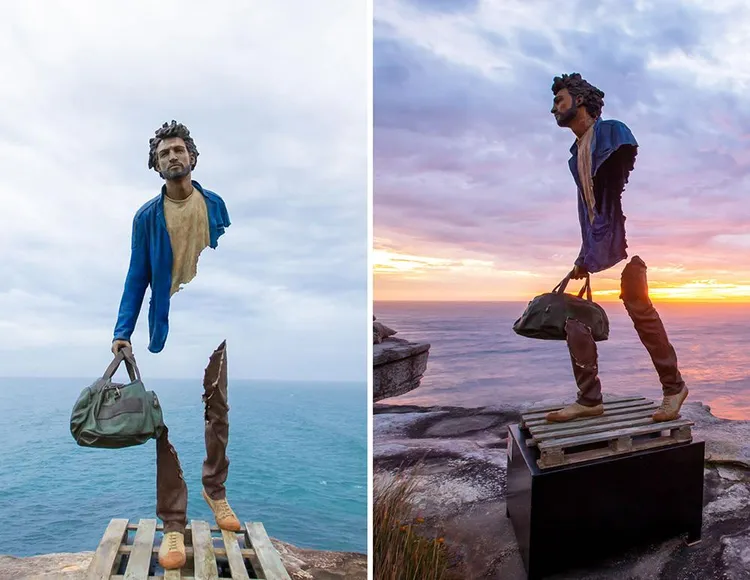THE complex experience of emigration is not always easy to describe in words, as I often find in my profession as an emigration therapist. Unlike a medical specialist who can use anatomical plastic models of knees and shoulders to explain a problem, describing a vague emotion like unresolved loss is a challenge.
In the long silences that are inherent in conversations with emigrants, I sometimes wish there was a visual representation that could reflect the essence of emigration — something that could help explore the deeper emotions of the emigrant.
The question of what emigration “looks like" and whether it is possible to capture it in a single image, photograph or work of art highlights the nature of this phenomenon. It is an interesting challenge to capture the essence of emigration through a model or visual representation.
Bittersweet stories
Emigration is often romanticised as a fairy tale-like journey to a new beginning, prosperity, security and happiness. But emigrants' stories often paint a very different picture — they are steeped in complexity and confusing and often conflicting emotions.
Emigrants find themselves in a new, unknown world: in the midst of foreign cultures and other customs. The full spectrum of emotions that accompany emigration cannot usually be anticipated. This is not a mere experiment that can be reversed without consequence.
These in-between spaces have a far greater impact than places of departure and arrival evidenced by a passport full of stamps. The sum total of emigration is much more than the physical change of residence. The bittersweet reality of this life-changing process also includes an emotional journey of change, letting go and starting a new chapter.
Lees hierdie artikel in Afrikaans:
The emigrant as artist
“Have you seen all these sculptures?” reads a friend's message with a picture of broken figures. These are life-size, striking sculptures of people on their way somewhere, suitcase in hand, with parts of their bodies hollowed out. Yet they keep their balance in the wind and the weather.
This is the art of the French sculptor Bruno Catalano. His works reflect a deep empathy and understanding of the emigrant's experience. His inspiration is rooted in his personal experience of leaving almost everything behind to face an uncertain future.
He was born in 1960 in Casablanca, Morocco. His family moved to Marseille when he was 10. He was trained as an electrician by his father and later worked on ships. It was only in his thirties that he discovered and began to exploit his passion for art and clay sculptures
In September 2013, ten of Catalano's life-size bronze sculptures were exhibited in the port of Marseille to celebrate the city's status as the European culture capital. These figures are now displayed all over the world and his most famous work has found a permanent home in Calgary, Canada.
Catalano's art is known for the large gaps in the bust area, depicting the incompleteness of these figures. Because of this negative space, you can see right through the figure. The void does not prevent the figure from continuing to move purposefully forward as it remains in delicate balance.
His art is distinguished by the careful and symbolic approach to the theme. He deliberately “tears" these figures in the wax stage, a process that reflects the pain of separation that emigrants often experience. These physical tears are not just an artistic expression — they depict emotional experiences and symbolise the inner struggle of those torn between two worlds.
Emotional gravity of emigration
Notable are the bags that each figure carries. The case connects the hollowed out part of the chest with the bottom of the sculpture — the only link between the head and the feet, between thoughts and body.
For Catalano, the suitcase is more than a mere container to cart possessions around. It is a symbol of the memories and personal experiences that anchor emigrants and connect them to their roots and places of origin.
The suitcase personifies the past and experiences of the once known, providing the necessary support to project the sculpture forward on its journey to unknown destinations.
Picking up the suitcase and walking away from the familiar indicates a resilience. It shows a willingness to embrace change, to keep exploring new horizons and to face the challenges ahead with courage.
In the language of Catalano's art, the suitcase becomes the symbol of a life in transit, the constant search for a place to call “home" in a changing world.
A universal nomadic experience
Artists often use their personal experiences to express a universal experience. It resonates within communities, locally and even globally. The “in transit" sculptures bridge the gap between the outer world of experiences and the inner world of emotions.
These works of art not only speak to the journey of emigrants but also personify the broader life journey of man with all his vulnerabilities. Wordlessly, they speak to the heart of the emigrant, as well as to the nomadic spirit in each of us. This unique art emphasises the journey rather than just the destination.
Maybe this is exactly what emigration looks like?
Sulette Ferreira (PhD) is a social science researcher and emigration therapist in private practice in South Africa. She specialises in the emotional effects of emigration.
♦ VWB ♦
BE PART OF THE CONVERSATION: Go to the bottom of this page to share your opinion. We look forward to hearing from you.






To comment on this article, register (it's fast and free) or log in.
First read Vrye Weekblad's Comment Policy before commenting.